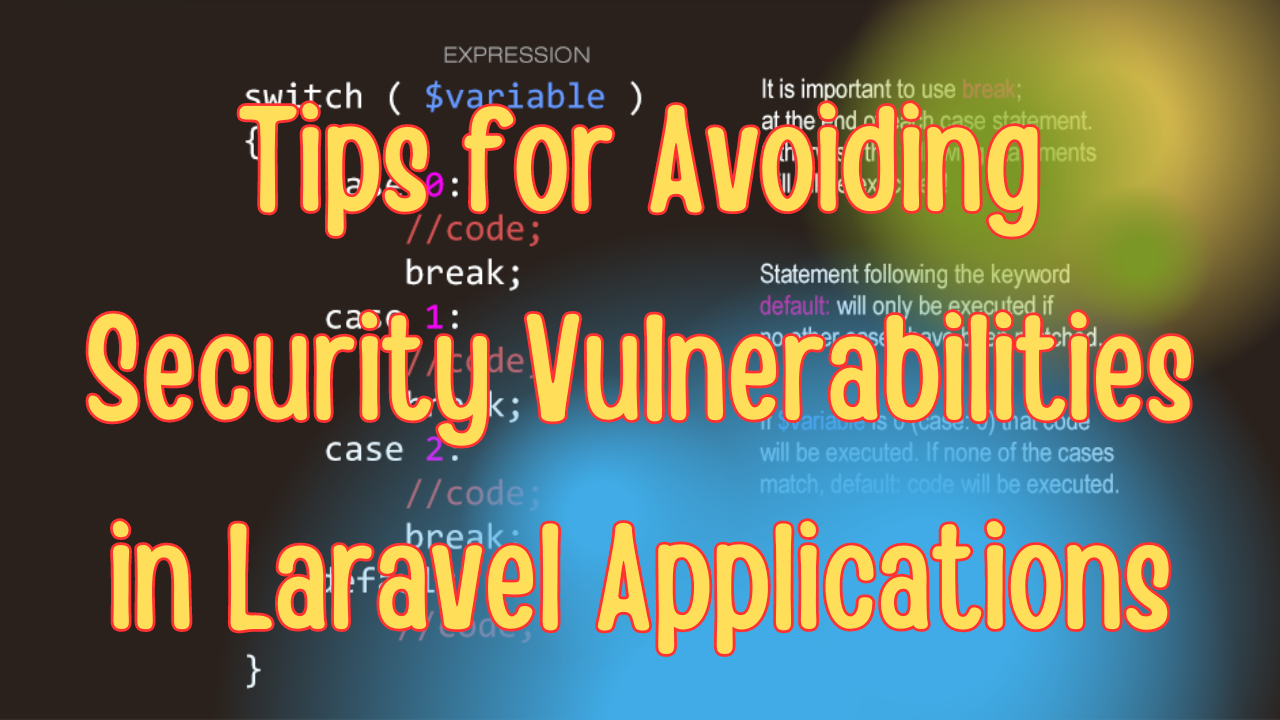Laravel is a popular PHP framework known for its elegant syntax, robust feature set, and powerful tools for building web applications. However, like any web framework, Laravel applications are vulnerable to various security threats if not properly secured. This blog post will cover essential tips to help you avoid security vulnerabilities in your Laravel applications, ensuring that your web apps are safe and secure from common attacks.
1. Keep Your Laravel Application Up-to-Date
Problem: Outdated versions of Laravel and its dependencies can contain security vulnerabilities that attackers can exploit.
Solution: Regularly update your Laravel application to the latest version. Laravel frequently releases updates that patch security vulnerabilities, fix bugs, and introduce new features. Use Composer to update Laravel and its dependencies:
composer update
Make sure to read the release notes and upgrade guides provided by Laravel to stay informed about changes that may affect your application.
2. Use Environment Configuration (.env) Correctly
Problem: Exposing sensitive data in the .env file or misconfiguring it can lead to serious security breaches.
Solution: Ensure your .env file is not publicly accessible. In production, never expose sensitive information like API keys, database credentials, or third-party service tokens. Additionally, set proper configuration values for security-related settings:
APP_DEBUG=false
APP_ENV=production
Setting APP_DEBUG=false ensures that detailed error messages are not displayed, which could expose sensitive information about your application.
3. Sanitize and Validate User Input
Problem: Unsanitized user input can lead to various attacks like SQL injection, Cross-Site Scripting (XSS), and Cross-Site Request Forgery (CSRF).
Solution: Always sanitize and validate all user inputs. Laravel provides powerful validation rules that you can use to ensure that input meets specific criteria:
$request->validate([
'email' => 'required|email',
'password' => 'required|min:8',
]);
To prevent XSS attacks, use the {{ }} syntax in Blade templates, which automatically escapes HTML entities. If you need to output raw HTML, use {!! !!} cautiously.
4. Protect Against SQL Injection
Problem: SQL injection is a common attack vector where an attacker can manipulate SQL queries to gain unauthorized access to the database.
Solution: Use Laravel's Eloquent ORM or query builder, which automatically protects against SQL injection by binding parameters. Avoid raw SQL queries unless absolutely necessary. When using raw SQL, use parameter binding to avoid injection:
DB::select('SELECT * FROM users WHERE email = ?', [$email]);
5. Implement CSRF Protection
Problem: Cross-Site Request Forgery (CSRF) attacks trick authenticated users into performing actions they didn't intend to.
Solution: Laravel includes CSRF protection by default. The VerifyCsrfToken middleware automatically checks for a valid CSRF token in every POST, PUT, PATCH, or DELETE request. Ensure that you include the @csrf directive in your Blade forms:
<form method="POST" action="/update-profile">
@csrf
<!-- Form fields -->
</form>
6. Use Laravel Authentication and Authorization Features
Problem: Improper authentication and authorization handling can lead to unauthorized access to sensitive data or functionality.
Solution: Use Laravel's built-in authentication and authorization features to manage user access. You can easily implement login, registration, and password management with Laravel Breeze, Fortify, or Jetstream packages. For authorization, use Gates and Policies to define fine-grained access control:
Gate::define('update-post', function ($user, $post) {
return $user->id === $post->user_id;
});
7. Encrypt Sensitive Data
Problem: Storing sensitive data like passwords, credit card details, or personal information in plain text can lead to data breaches.
Solution: Always encrypt sensitive data using Laravel's built-in encryption capabilities. Laravel uses bcrypt for hashing passwords, which is a secure and industry-standard method:
use Illuminate\Support\Facades\Hash;
$user->password = Hash::make($request->password);
For other sensitive data, use the Crypt facade to encrypt and decrypt values:
use Illuminate\Support\Facades\Crypt;
$encrypted = Crypt::encryptString('Sensitive Data');
$decrypted = Crypt::decryptString($encrypted);
8. Set Up HTTP Security Headers
Problem: Without proper HTTP security headers, attackers can exploit various vulnerabilities like XSS, Clickjacking, and more.
Solution: Use the Laravel HTTP Headers package or configure middleware to set HTTP security headers. Some essential headers include:
-
X-Content-Type-Options: nosniff -
X-Frame-Options: DENY -
Content-Security-Policy: default-src 'self' -
Strict-Transport-Security: max-age=31536000; includeSubDomains
9. Implement Rate Limiting
Problem: An API or web application that does not implement rate limiting can be susceptible to brute force attacks or DDoS attacks.
Solution: Laravel provides an easy way to implement rate limiting using the ThrottleRequests middleware. You can configure rate limiting in your routes/api.php file:
Route::middleware('throttle:60,1')->group(function () {
// Routes
});
This configuration allows a maximum of 60 requests per minute.
10. Regularly Audit and Monitor Your Application
Problem: Security vulnerabilities can arise due to outdated dependencies, misconfigurations, or newly discovered exploits.
Solution: Regularly audit your Laravel application and its dependencies using tools like Composer Audit, Laravel Security Checker, or OWASP ZAP. Additionally, monitor your application using logging and monitoring tools like Laravel Telescope, Sentry, or LogRocket to detect suspicious activities or errors in real time.
Conclusion
Securing a Laravel application involves more than just writing secure code; it requires a comprehensive approach that includes configuration, validation, encryption, monitoring, and regular updates. By following these tips, you can avoid common security vulnerabilities and build more secure, reliable, and robust Laravel applications.
Stay proactive, keep your applications up-to-date, and continually educate yourself on the latest security practices to keep your Laravel applications safe from potential threats.




